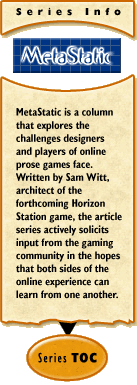 The Value of the Random Dungeon
The Value of the Random Dungeon
by Sam Witt
February 14, 2001
Over in the Storybuilder's forum there has been some discussion about dynamic worlds, which sparked this installment of MetaStatic.
Exploration is a big part of what gamers like, the thrill of finding somewhere unexplored, or discovering some trinket on the body of a fallen foe. The problem is that players, as a rule, spend a lot of time exploring, and almost as much time sharing the news of their discoveries. Beleaguered game designers design new areas as fast as they can, but it never seems to be fast enough.
While painstakingly detailed areas are great, they are also part of the problem. I'm probably going to take a lot of flack for this, but I feel that a lot of the detail work is being wasted on areas that players pay little or no attention to. And if players aren't spending any time looking at the coffee stains on a desk, why put 'em there in the first place?
In order to keep up with player demand, and create very large gaming environments, random design elements need to be incorporated. Stop your screaming, it's not as bad as you think.
Random dungeons are nothing new – they've been in use for a good long time, and have earned the enmity of players worldwide. Stale, flavorless, and illogical, random dungeons just weren't much fun. But that doesn't mean they have to stay that way.
While designing Horizon Station, I kept getting lost in all this empty space. The asteroid belt surrounding the Station itself takes up thousands of cubic miles of space, and then there's all that black emptiness out beyond belt. Space is big, and to give an impression of just HOW big, was going to take work. Way, way too much work.
The same problems exist in fantasy worlds, or even modern worlds. There must be the idea that the world is big, but making a really big world is a task of monumental proportions. Assuming your room descriptions are an average of 50 words, even a small setting of 2,000 rooms is the equivalent of writing a novel. That's just too much, especially when a good percentage of the words you write won't be read more than a single time by any player.
I'm not going to pretend that I have the answer, but I think that part of the solution to adding new content is going to be the use of random generators combined with a number of 'themed' room descriptions. Using the power of SAM (that's Skotos Active Markup), you can actually use a single room description for any similar room, and get a number of different descriptions out of it.
For example, let's use the concept of a space station corridor. It's a pretty simple section with metal deck plates, some exposed conduit (both electrical and fluid), some light panels here and there, and a variety of mechanical bits that protrude in odd places and look spiky and strange. Every section of corridor in the station is pretty much the same, with exceptions for those that lie at intersections or have doors adjoining them.
In the past, you'd have to write a description for each and every section of corridor you placed. In a large setting, that would become painfully tedious, you'd have hundreds of rooms that would need similar, but slightly different, descriptions. How boooooring.
Fortunately, that's no longer the case. With SAM, we can just write ten basic variations of the description of each element, nest them all into some wicked cool one-ofs (an array of choices from which the system picks what characters see), and you can generate thousands of variations on a theme. With just the four of five elements listed above, and ten variations of each, you've planted the seeds for 100,000 rooms. Even better, you can periodically add new descriptions to your base room, which increases the number of variations of that room the system can create.
Expanding this idea further, you can create huge amounts of game environment from a single set of building blocks. Create a block for forests, one for swamps, one for mountain areas, there are countless possibilities. Once you have your building blocks, use them to fill in your world, and reserve the real work for areas of special interest.
And there's no reason to stop at just creating building blocks for rooms. When designing adventuring locations, pick out some 'stock' rooms that should be present in each, and then build your new locations from those. Using an example from Horizon Station, the warhulks that float through the asteroid belt are of ten basic types, and each of those types has a somewhat standardized layout. Because I've decided what elements are used to construct each warhulk, I can quickly generate a lot of these adventuring locations, and using the randomization of descriptions, I won't bore players with repetitions of the same room text.
The other advantage of this system is that it forces designers to think in terms of themes. If you're going to be mixing and matching components, you have to be sure that they all fit together in a way that will be logical, no matter which elements appear in the final design. This, I think, strengthens the feel of an area considerably, and reinforces the moods and impressions on the players.
As always, use the link below to tell me just how wrong I am. Go ahead. Click it.



